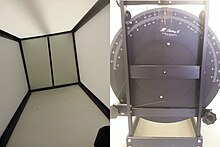Field dependency
Field dependence describes a cognitive style based on Herman Witkin and his later generalizations.
In the case of a field-dependent perception style, the perceptual environment has a strong influence on the perceived figure, while in a field-independent perception mode, the perception is directed towards the object to be perceived. Field dependence or field independence are viewed as relatively consistent personality traits .
Originally, the concept was examined primarily in the perception of geometric figures that are embedded in complex figures and had to be recognized or recognized ("embedded figures"). Later, the vertical in the room was determined in the event of conflicts between information from different sensory channels (e.g. inclined glow sticks, distorted perspectives, differently tilted or tiltable chairs for the test subjects and the glow stick had to be adjusted). Another arrangement was the " Rod and Frame Test " RFT (see picture), where the angle of the vertical rod is to be set.
It was shown that field-dependent people differ from field-independent people in many other areas (e.g. undifferentiated defense mechanisms, more direct and uncontrolled expression of aggression, reporting fewer dreams, preferring more intuitive methods - compared to more hypothesis-testing in those who are more field-independent). The choice of profession is also preferred more towards mathematics / natural sciences. Field-independent people are more active, more self-confident, more resistant to suggestions, more non-conformist, stronger ego and more independent. Field addicts are characterized by a lack of self-insight, inhibition of drive, feelings of inferiority and submissiveness. Relationships with upbringing were also discussed.
Individual evidence
- ↑ Witkin, HA et al. (1954) Personality through perception. New York: Harper.
- ^ Dorsch Lexikon der Psychologie - Verlag Hans Huber - keyword detail page. In: portal.hogrefe.com. Retrieved February 17, 2016 .
- ↑ Prof Francesca Happé: Embedded Figures Test (EFT) . In: Encyclopedia of Autism Spectrum Disorders . Springer New York, 2013, ISBN 978-1-4419-1697-6 , pp. 1077-1078 ( springer.com [accessed February 17, 2016]).
- ↑ Amelang, M .; Bartussek, D. et al. (Ed.): Differential Psychology and Personality Research. 6th edition. Verlag W. Kohlhammer. P. 441 ff.
- ^ M. v Kerekjarto: Medical Psychology: Basic Text Medicine . Springer-Verlag, 2013, ISBN 978-3-642-66300-0 ( google.com [accessed February 17, 2016]).
